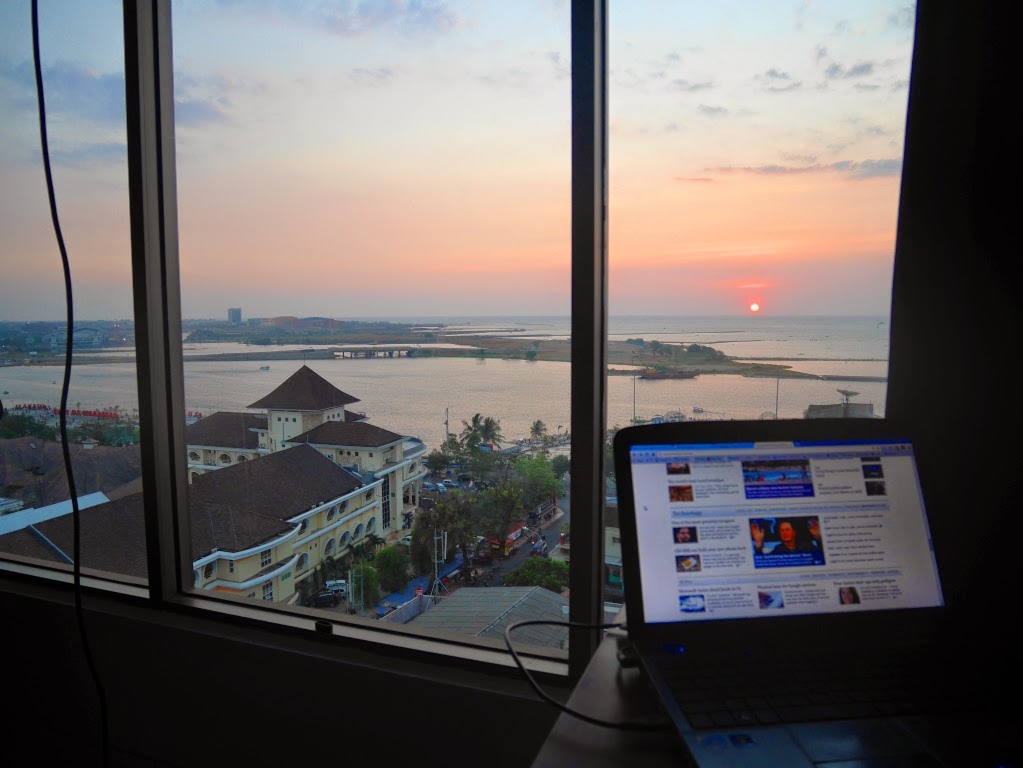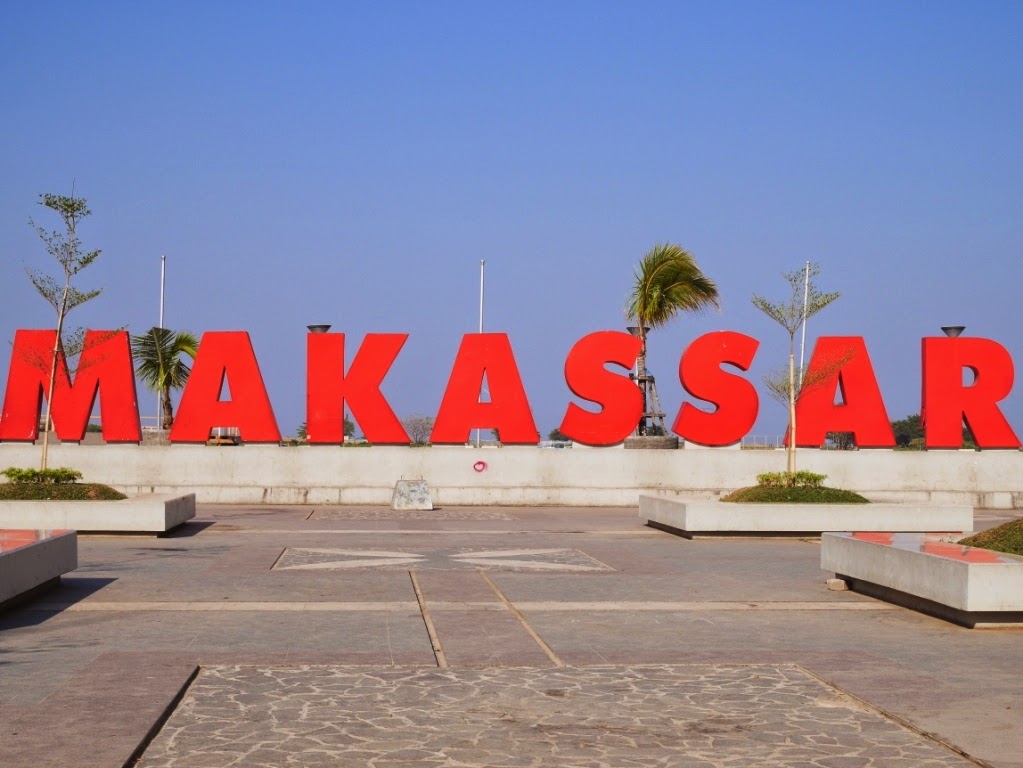Apart from our trip to Kalimantan to see the orangutans and back to Australia to see our closer relations, we've been happily ensconced here in room 1119 at the Fave Hotel, subjected to nightly sunsets over the Makassar Strait through our massive picture windows. Hard life, but someone’s got to keep the hotel industry afloat. Photos don’t do it justice, but here’s one anyway.
 |
| Tough gig, I know. |
Well, I have started jogging again, along with the rest of Makassar, at Karebosi sportsground. You have to go before 7 a.m. or it's too hot.
 |
| "Jogging" here means walking in sportswear. You'll be pleased to know I have been doing it properly. |
 |
| Another tough gig ... for the other guy. |
Somehow in the 6 weeks or so that I've taken classes there, I haven't taught the same class twice. I estimate I've seen around 300 different students. The final class was a group of about 20 Papuan students who have scholarships to go to university in the USA starting next year. They are here in Makassar to hone their English skills before they sit a final IELTs test that will determine if they can go. They are a wonderfully positive bunch of youngsters.
My finishing up at the school coincided with their arrival in Makassar, so a combined welcome/farewell party was held last Friday at which I was presented with a trophy and a huge tiramisu cake, and the Papuan students performed a couple of songs with great gusto.
 |
| Steve's abridged history of Australia, including diagram showing early seafaring contact between Buginese sailors and Top End Aborigines, plus boomerang-throwing technique. |
 |
| The Papuan students |
When I look back at my first blog post from February, I was joking about putting the mysterious town of Polewali 'on the map'. As it turns out, I don’t expect Polewali will experience a huge upswing in tourism due to my blog posts, which were more a 'warts and all' kind of expose. What I have turned my attention to is putting Makassar on the map; or more correctly, putting the map on Makassar.
Living in Melbourne you get the sense that whatever you want to know about the place – which restaurants are hot, what’s on at the rooftop cinema, how to get from Footscray to Doncaster by bus – it’s all just a Google search away. You can be confident the information's out there somewhere, probably in an interactive user-friendly format. It’s been interesting to be somewhere where that isn't the case. Makassar doesn't exist in cyberspace, except in random bits and pieces.
One of the first ways I bumped up against this was when I started using the tiny micro-buses called pete-pete that are Makassar’s only form of public transport. The vehicles themselves are Suzuki "Carry" vans fitted out with rudimentary bench seats for up to 10 passengers, plus the seat next to the driver. Many of them are seriously beaten up but any discomfort is usually offset by a sound system with sub-woofers playing dangdut.
 |
| The humble pete-pete (route E: Makassar Mall to Panakkukang) |
 |
| The not-so-humble sound system |
That turned out to be the thrown-down gauntlet I needed.
I spent the next couple of weeks travelling the pete-petes, tracking the routes on my phone, comparing them with some lists I had managed to find on a blog site, then combining it all into some new Google’s maps. I got to about 10 and figured I’d probably covered most of the main routes that other tourists would want to travel.
Here's one I prepared earlier. You click the little white box to see the routes.
Getting a bit carried away with the whole mapping thing, I created another one showing all the places we've eaten, shopped, visited, etc. The kind of information we've found out by being here and being shown around by locals and expats, and that other travellers might find useful too.
Great, so I now had a bunch of maps. But to be of any use to anyone, they needed to be findable, and to be findable they really needed to be part of a website, and to be part of a website, I would need to ... make a website. Which was how I ended up on Weebly, a kind of "Make Your Own Instant Website for Dummies". About 3 weeks later, it's just about done. (Heck, I needed a project to keep me busy.) It still has a few gaps to be filled, and I'm sure you'll spot typos on the first page, but here in all its glory is [drum roll, please] ...
(aka The Other Sulawesi Project)
OK, so that's done.
This week we're also saying goodbye to the small group of people we know here in Makassar. One of them is a young man called Azimi, who we met maybe 2 months ago on one of our nightly walks at Pantai Losari. Azimi is a young Hazara man from Afghanistan who has worked, indirectly, for the international forces there. Those two things make him a target for retribution by the Taliban, which is why he left Afghanistan and made his way here. He has been in Indonesia for a year now and is still waiting for his case to be assessed by the UN to determine whether he is a genuine refugee. He's quietly confident that will occur, and also that his chances of being accepted into Australia are fairly good. But he may have to be here for another 12 months or more, waiting.
I can't help but be struck by the difference between his treatment here and the treatment of asylum seekers who made their way to Australia. Here Azimi is living in a basic hotel along with a group of other Afghani men, supported by the International Office for Migration. He's not able to work but he is able to move around freely in the community. He's not vilified by the locals, in fact he has made some Indonesian friends and is learning the language, as well as running English lessons for his compatriots. He is not locked up like a criminal. And this is in a country that is still struggling to lift 28 million of its own people out of poverty. Meanwhile asylum seekers in Australia are suffering extreme hardship with no prospects of resettlement.
Over the past couple of months, Azimi and I have had lots of walks around Makassar and adventures trying to find our way by pete-pete. I really hope I can take a Melbourne tram ride with him sometime soon.
 |
| Me and Azimi, out on a pete-pete adventure. We didn't plan the matching shirts, honest. |
And that's just about a wrap. It's been a crazy 9 months, a jump into the unknown. We've seen a lot of South Sulawesi and a lot of cocoa trees and just when that started to wear thin we stayed put in Makassar long enough for me to rediscover my inner editor and try to bring order to chaos. So, if your partner comes home one night and says they've taken on a project in some place you've never heard of ... I say go for it. If they don't, suggest a trip to Polewali anyway. Maybe you can put it on the map!
Am I sad to be leaving? Yes, I am. Despite the heat and the noise and the lack of footpaths and our slightly surreal hotel-based daily life, I must have put a few roots down into Makassan soil and I will feel the wrench as our plane takes off on Thursday evening. I'll miss the people we've shared our time here with, and the smiling "Selamat pagi"s as I step out of the lift each morning.
Bye Makassar, South Sulawesi. Sampai jumpa lagi!
















































